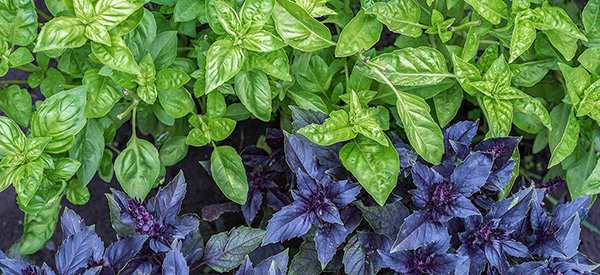
Basil
Basil (Ocimum) is a popular aromatic cooking herb in many countries. However, it has also traditionally been used for its various health-giving properties and is currently enjoying a rediscovery.
This annual plant is part of the Mint family and is also known as St Joseph’s Wort (not to be confused with St John’s Wort).
There are several varieties including Sweet (Ocimum basilicum), Holy (Ocimum tenuiflorum), Lemon (Ocimum x citriodorum), and Thai Basil (Ocimum sanctum). Sweet Basil is the one that is used most in cooking outside of Asian countries which favor the stronger Thai variety.
In addition to offering flavor and fragrance, Basil contains several minerals, vitamins, and antioxidants. Holy Basil is considered the most beneficial variety, but Sweet Basil also offers medicinal properties.
The History of Basil
This herb has a rich and varied past that spans more than 4 millennia. It was perceived as having mystical / spiritual, health-giving, and culinary value at various times and in a range of countries.
Ancient Egyptians used Basil as part of the embalming process, and the plant was a symbol of mourning in Greece. It was viewed as having the ability to protect the vulnerable, and in India and Crete this herb was planted or placed around temples and homes to ward off evil. It was an important part of Ayurvedic medicine for many centuries. In Portugal, Basil was given as a gift to a sweetheart on certain important holidays. Various faiths, including Judaism, used this herb to give the body and spirit strength during periods of fasting.
In Medieval times Basil fell out of favor in some areas where healers believed that the herb was in fact poisonous. The 16th century saw the introduction of Basil into the UK and then to North America. It is now easy to obtain in either fresh and / or dried form almost worldwide.
Where This Plant is Found
Basil originated in Africa and Asia. It grows well in areas where conditions are hot and dry and is sensitive to cold. It has now been introduced to southern Europe, Northern Australia, New Zealand, Southeast Asia, the Southern US, and throughout the Mediterranean region.
Related: The Complete Map of Edible Plants: Find Out What You Have in Your Area! (Video)
How to Identify Basil
Given there are several popular – some common and others less so – varieties, they need to be described separately.
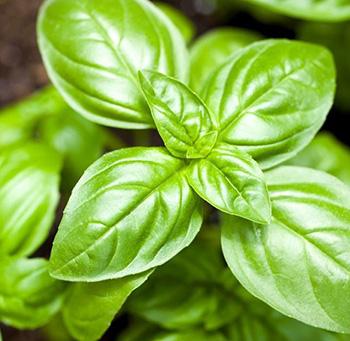
Sweet / Italian Basil: This variety forms a compact, low bush.
- Leaves: The leaves are a bright glossy green, oval, and have light green veins and pointed tips.
Mature leaves often curl under slightly at the edges giving them a cup-like and slightly puckered appearance.
- Flowers: The flowers appear in clusters at the end of stalks. They range in color from white to magenta.
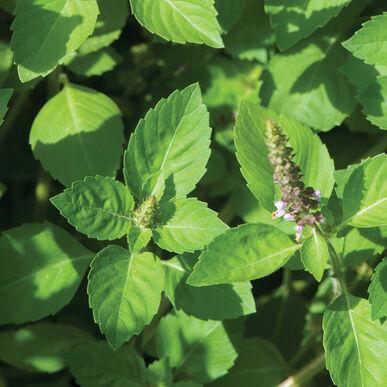 Holy Basil / Tulsi: This herb can grow to a height of up to 3.3 feet / 1 meter and has a spicy, musky scent. It is a sacred plant for Hindus.
Holy Basil / Tulsi: This herb can grow to a height of up to 3.3 feet / 1 meter and has a spicy, musky scent. It is a sacred plant for Hindus.
- Leaves: The leaves are dark green, oblong, pointed, speckled, and usually covered in soft hair.
They are much smaller, narrower, and pointed than other varieties. They are also quite bitter if eaten raw.
- Flowers: These tiny flowers are pink, lavender, purple, or even crimson.
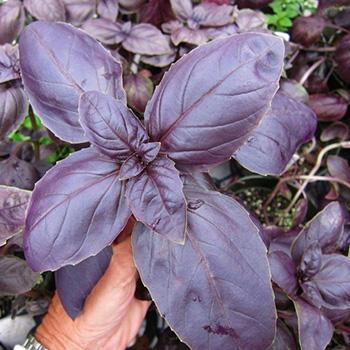
Purple Basil: This plant is less sweet and has a slight taste of cloves.
- Leaves: The leaves are a dark burgundy color and are similar in shape to those of Sweet Basil but larger.
However, the leaves are more deeply veined and don’t curl the same way.
- Flowers: As with other varieties, the flowers are small and bloom in clusters on the ends of stalks. This type of Basil has white or pink flowers.
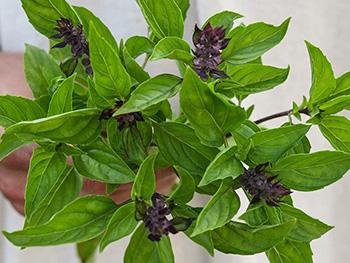
Thai Basil: This basil has a much spicier taste, and the leaves are usually only used in cooking rather than eaten raw.
- Leaves: The leaves are smaller and lighter in color than those of Sweet Basil.
They are smooth, serrated, the veins are bright yellowish-green, and the stalks are dark purple.
- Flowers: The buds are purple, but the small flowers are pink when they open.
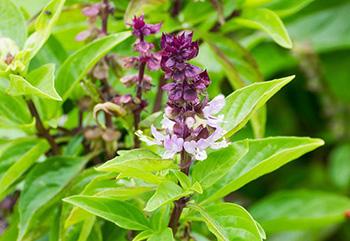 Cinnamon Basil: This is another variety that has a spicy aroma. However, the taste is milder and reminiscent, as the name implies, or cinnamon.
Cinnamon Basil: This is another variety that has a spicy aroma. However, the taste is milder and reminiscent, as the name implies, or cinnamon.
The stalks and stems are reddish-purple.
- Leaves: These leaves often have reddish stripes and are serrated, narrow, dark green, and shiny.
- Flowers: The flowers are pink when they open and, like all Basil varieties, form in clusters at the end of stalks.
This is by no means an exhaustive list as they are several other varieties available including Lemon Basil and Lettuce Leaf Basil. If a recipe – either a culinary or healthcare one – does not specify, it is safe to assume that the variety you need is Sweet Basil.
How to Grow Basil
Basil requires a sheltered position in full sun. If you live in an area where the weather can get cold, you will find it much easier to grow this herb in a pot or window box in a position such as on a warm windowsill, for example. Basil will not survive frost or winters outdoors. Some people grow Basil in pots that stay outside in warm weather and are brought in when the seasons change.
In terms of other general growing conditions, Basil requires good, rich, well-drained soil. If you are planting this herb outdoors, only do so when the air temperature is above 100 Celsius / 500 Fahrenheit.
You have options when it comes to planting or propagating:
 Seedlings: This is of course the easiest planting option. Simply purchase a young plant and transfer it into a suitable location outdoors or into an appropriate size pot in a light, warm place in your home. Select a pot that will accommodate a mature plant so that you don’t have to repot at some point.
Seedlings: This is of course the easiest planting option. Simply purchase a young plant and transfer it into a suitable location outdoors or into an appropriate size pot in a light, warm place in your home. Select a pot that will accommodate a mature plant so that you don’t have to repot at some point.
- Seeds: These should be planted at a depth of ½ centimeter / 0.2 inches and 10 centimeters / 4 inches apart.
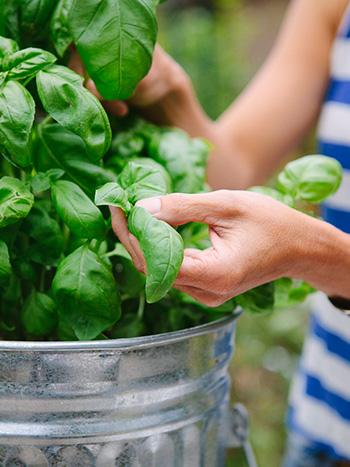
Don’t plant too many as they have a high germination rate. Once they have developed the first mature leaves, the young plant can be moved to a larger pot or to a suitable spot outside. It will take a couple of months before you can begin harvesting leaves.
- Cuttings: This is a quicker option than growing this herb from seeds. If correctly done, it also allows you to have a steady supply of fresh Basil.
You can start cuttings either in water or soil; the first is perhaps more common. Each cutting should be 4 – 6 inches / 10 – 15 centimeters long and cut off at an angle just below a leaf node. Strip the leaves from the lower third of the stem.
If you are rooting in water, use filtered water if possible. Tap water should be left to stand for 24 hours before you use it. Place the cuttings in the water in a glass jar, ensuring that no leaves are below the water as they will rot. Stand the jar in bright light but not direct sunlight and change the water every second day. This prevents the formation of algae. Use a spray bottle to mist the leaves daily. Once the cuttings have formed roots (in 10 – 14 days) you can transfer them into moist potting soil.
To root cuttings in the soil you should prepare the pot by filling it with moist potting soil. Make a small hole in the soil. Take your cuttings and place each one into the soil immediately to prevent the cut end from drying out. Push the soil firmly around the cutting. Stand the pot in bright light but not direct sunlight and use a spray bottle daily to mist the leaves. Don’t use hormone or rooting powder for edible plants such as Basil. You will know the cuttings have rooted when new roots appear. After a few weeks, you should be able to transplant the cuttings if you need to.
 Your Basil plant will be more productive, and remain healthy and bushy for longer, if you pinch off the tips of the stalks as – or before – buds and flowers form.
Your Basil plant will be more productive, and remain healthy and bushy for longer, if you pinch off the tips of the stalks as – or before – buds and flowers form.
Apart from being tender, this herb is unfortunately prone to some problems and pests:
- Pests: Aphids, slugs, and/or snails
- Brown spot (caused by a bacteria)
- Yellow leaves (often caused by overwatering).
If your plants are outdoors and fall prey to pests, remember to use organic, natural, and non-toxic remedies so you can still eat your Basil.
If Basil is in the right location, cared for, and happy, it is a vigorous plant that will reward you with leaves all year round. This is particularly the case if you grow this herb indoors as it can’t withstand cold weather.
How to Harvest This Plant
The optimal time to harvest is before Basil flowers. Use kitchen scissors or shears to cut off the stalks. If you only want a few leaves you can pinch them off with your fingers. Ensure that you leave enough stalks and leaves on the plant for it to continue to grow and be healthy.
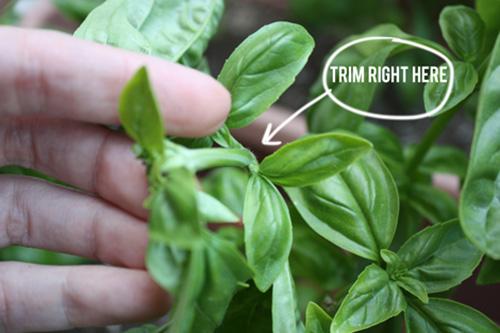
Don’t use any leaves that are carrying pests, are yellowed, speckled, or misshapen. If you are not careful and gentle, Basil leaves bruises and blacken easily. These leaves may taste okay, but they don’t look very appealing.
The best time of day to harvest is early morning after the dews have dried.
What Basil is Good for And The Natural Remedies Made From It
Basil is of value both in our diet and our wellness regimen. It is believed that 1 tablespoon of Basil contains the following nutrients: Calcium, Vitamin A, Vitamin K, Vitamin Bs, Vitamin C, Lutein and Zeaxanthin, Beta carotene, Manganese, and Beta cryptoxanthin. There also minerals such as trace elements of calcium, iron, magnesium, and several antioxidants.
It should be noted, however, that while Sweet Basil has value and features in cooking in many countries, it is Holy Basil that is considered to offer more significant health benefits. It should also be kept in mind that although there is considerable anecdotal evidence, there is little clinical evidence about the efficacy of Basil.
Historically, Basil has been used to:
- Heal minor cuts and wounds
- Soothe inflammation and infection of the skin
 Alleviate some of the effects of chronic and/or oxidative stress
Alleviate some of the effects of chronic and/or oxidative stress- Balance blood sugar and cholesterol levels
- Lower blood pressure
- Soothe gastric inflammation
- Ease the inflammation of the throat caused by colds
- Increase mental alertness
- Combat some strains of bacteria
- Repel insects and so prevent bites and stings.
While adding Basil to your diet won’t offer all these benefits, many of them can be obtained from Basil Oil and or Tea made from Holy Basil.
What Parts of The Plant are Used in Remedies?
Unlike many other medicinal plants and herbs, only the leaves and young stalks are used in the production of various remedies and in cooking although the seeds may also be used.
A DIY Basil Recipe
If you are looking for a way to soothe a minor wound, a skin abrasion, or an insect bite or sting, a poultice made with fresh Basil is both easy to make and use and effective.
Ingredients and equipment:
- A large bunch of fresh Sweet Basil
- A rolling pin
- Cling film or a similar wrapping material
- A piece of clean cotton, muslin, or clean and lint-free fabric.
If you can’t get fresh Basil, you can use dried herbs by grinding it to powder and adding water to form a paste. However, this won’t be as effective.
Method:
- Trim off the large or thick stalks

- Crush the smaller stalks and leaves using the rolling pin

- Apply the Basil ‘paste’ to the affected area
- Cover the paste with a suitable cloth
- Wrap plastic wrap or some other material around the affected part of the body to keep the poultice in place and prevent leakage.
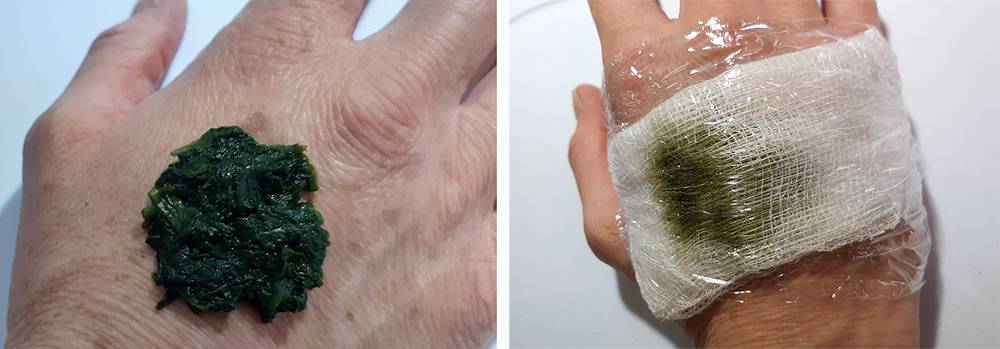
Directions:
- Leave the poultice in place for up to 2 hours
- Remove the plastic and cloth covering and dispose of them
- Rinse off any remaining plant material
- Gently dry the affected skin
- Reapply the poultice daily for 7 days or until all the swelling, itching, and inflammation is gone.
And a bonus recipe: Basil Tea
For this you will need:
- 6 – 8 sprigs of Holy Basil
- 6 cups of pure or filtered water.
- Place the Basil into just-boiled water
- Push the springs under the water
- Cover the container and leave it to steep for 10 minutes
- Remove the Basil springs and pour the tea.
This tea is reported to soothe gastric ailments and have a calming effect.
Dosage
Due to the lack of clinical studies, especially with human subjects, there are no current guidelines in terms of safe doses for various Basil remedies. The only recommendation, therefore, is to follow the advice of a healthcare practitioner and/or adhere to the directions on product packaging.
How to Preserve This Plant
If you want access to this herb at a time when fresh Basil isn’t available, you can either dry or freeze fresh leaves. In either case, remember to handle the leaves carefully as they bruise, blacken/discolor, and release their oils if roughly dealt with.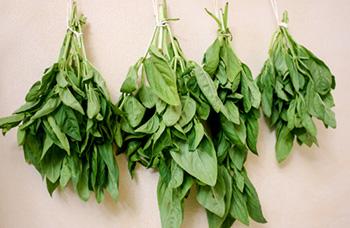
- Air drying: Hang small bunches of Basil in a well-ventilated, warm, low-light area. Place small paper bags that have holes punched into them around the leaves. Leave them drying until the leaves are dry and crisp to the touch. They can then be removed from the stalks and put into airtight containers.

- Oven drying: Remove the leaves from the stalks, wash them, and dry them thoroughly. Put your oven on its lowest temperature. Spread the Basil out on baking paper on a baking tray. Place the tray on the top shelf and leave the leaves to dry until they begin to break up (2 – 4 hours). Allow the leaves to cool, crumble them into usable size pieces, and store them in airtight containers.
- Microwave drying: Lay the leaves on a paper towel, set the microwave to low, and ‘cook’ for 3 minutes. Check them every 60 seconds to see how they are drying and to ensure they don’t burn.
 Sun-drying: This is only possible in summer and if you have extended hours of sunny weather. Spread the leaves out on suitable racks or wire mesh screens. You could also use a clean bed sheet or other suitable fabric. The drying process will take several days, depending on how many sunny hours you have. Ensure the drying leaves can’t get wet or blown away. Once dry, store as before.
Sun-drying: This is only possible in summer and if you have extended hours of sunny weather. Spread the leaves out on suitable racks or wire mesh screens. You could also use a clean bed sheet or other suitable fabric. The drying process will take several days, depending on how many sunny hours you have. Ensure the drying leaves can’t get wet or blown away. Once dry, store as before. Freezing: You can also pick, wash, and dry Basil leaves and then puree them using a blender. Add a little water until the puree is the right thickness to be poured. Pour it into ice cube trays and freeze it. You can use as many cubes as you need when you need them.
Freezing: You can also pick, wash, and dry Basil leaves and then puree them using a blender. Add a little water until the puree is the right thickness to be poured. Pour it into ice cube trays and freeze it. You can use as many cubes as you need when you need them.
When storing dry Basil, remember to store it away from light and where the plant material will remain dry. Finally, keep in mind when you use them that dried herbs are three or even four times as strong as fresh ones.
Related: How To Properly Dry Plants for Medicine
What Plants Resemble Basil?
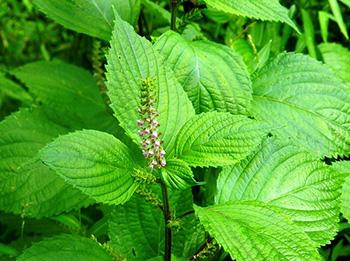
Apart from some varieties of Basil that look similar, a plant that may cause confusion is the Wild Sesame Seed plant (Korean Perilla). It is also edible and commonly used in Korean dishes. The leaves are similar in shape to some varieties of Basil. However, the underside of the leaf is pale purple, and the flowers are distinctive.
Warning and Cautions
There is not much information available specifically in relation to Basil-based remedies. However, some cautions and warnings are warranted, particularly in relation to Holy Basil.
- Vitamin K helps blood to clot which can be problematic for patients on blood thinners. Paradoxically, while this is true of fresh Basil, Basil Oil in fact thins the blood!
- Basil Oil should not be used for 2 weeks prior to surgery or by those with bleeding disorders
A small number of individuals may experience an allergic reaction. If this happens, stop using the herb and seek advice if the reaction is significant and/or prolonged.
If you have any doubts or concerns, consult your healthcare practitioner before using any remedy, including plant-based ones.
You may also like:
 Burdock: The Annoying Weed That Can Save Your Life
Burdock: The Annoying Weed That Can Save Your Life
Similar to Morphine: The Best Natural Painkiller that Grows in Your Backyard (Video)

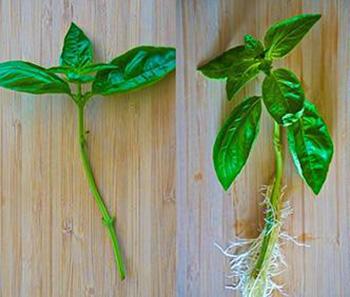 Seedlings: This is of course the easiest planting option. Simply purchase a young plant and transfer it into a suitable location outdoors or into an appropriate size pot in a light, warm place in your home. Select a pot that will accommodate a mature plant so that you don’t have to repot at some point.
Seedlings: This is of course the easiest planting option. Simply purchase a young plant and transfer it into a suitable location outdoors or into an appropriate size pot in a light, warm place in your home. Select a pot that will accommodate a mature plant so that you don’t have to repot at some point.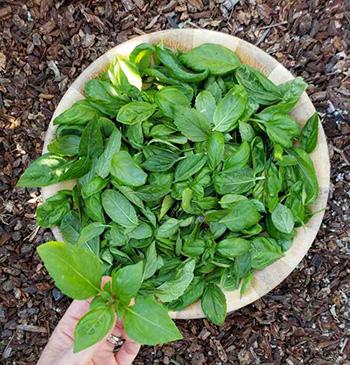 Alleviate some of the effects of chronic and/or oxidative stress
Alleviate some of the effects of chronic and/or oxidative stress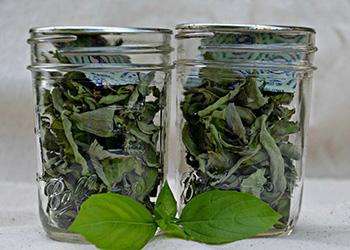
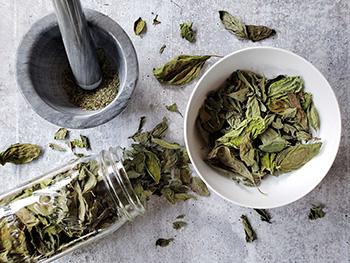 Sun-drying: This is only possible in summer and if you have extended hours of sunny weather. Spread the leaves out on suitable racks or wire mesh screens. You could also use a clean bed sheet or other suitable fabric. The drying process will take several days, depending on how many sunny hours you have. Ensure the drying leaves can’t get wet or blown away. Once dry, store as before.
Sun-drying: This is only possible in summer and if you have extended hours of sunny weather. Spread the leaves out on suitable racks or wire mesh screens. You could also use a clean bed sheet or other suitable fabric. The drying process will take several days, depending on how many sunny hours you have. Ensure the drying leaves can’t get wet or blown away. Once dry, store as before.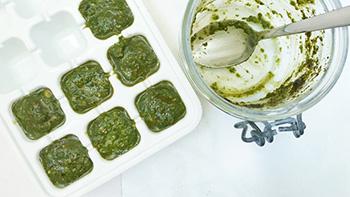 Freezing: You can also pick, wash, and dry Basil leaves and then puree them using a blender. Add a little water until the puree is the right thickness to be poured. Pour it into ice cube trays and freeze it. You can use as many cubes as you need when you need them.
Freezing: You can also pick, wash, and dry Basil leaves and then puree them using a blender. Add a little water until the puree is the right thickness to be poured. Pour it into ice cube trays and freeze it. You can use as many cubes as you need when you need them.
I just learned about opium lettuce and am making it now for my husband’s knee pain.